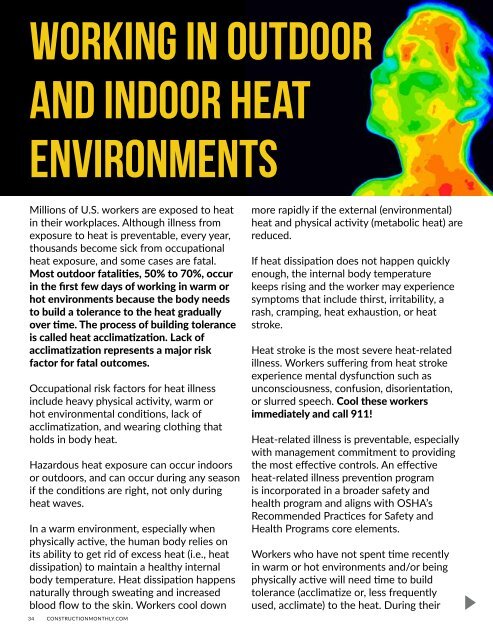Dallas 2020 Construction Monthly
You also want an ePaper? Increase the reach of your titles
YUMPU automatically turns print PDFs into web optimized ePapers that Google loves.
Working in Outdoor<br />
and Indoor Heat<br />
Environments<br />
Millions of U.S. workers are exposed to heat<br />
in their workplaces. Although illness from<br />
exposure to heat is preventable, every year,<br />
thousands become sick from occupational<br />
heat exposure, and some cases are fatal.<br />
Most outdoor fatalities, 50% to 70%, occur<br />
in the first few days of working in warm or<br />
hot environments because the body needs<br />
to build a tolerance to the heat gradually<br />
over time. The process of building tolerance<br />
is called heat acclimatization. Lack of<br />
acclimatization represents a major risk<br />
factor for fatal outcomes.<br />
Occupational risk factors for heat illness<br />
include heavy physical activity, warm or<br />
hot environmental conditions, lack of<br />
acclimatization, and wearing clothing that<br />
holds in body heat.<br />
Hazardous heat exposure can occur indoors<br />
or outdoors, and can occur during any season<br />
if the conditions are right, not only during<br />
heat waves.<br />
In a warm environment, especially when<br />
physically active, the human body relies on<br />
its ability to get rid of excess heat (i.e., heat<br />
dissipation) to maintain a healthy internal<br />
body temperature. Heat dissipation happens<br />
naturally through sweating and increased<br />
blood flow to the skin. Workers cool down<br />
34 CONSTRUCTIONMONTHLY.COM<br />
more rapidly if the external (environmental)<br />
heat and physical activity (metabolic heat) are<br />
reduced.<br />
If heat dissipation does not happen quickly<br />
enough, the internal body temperature<br />
keeps rising and the worker may experience<br />
symptoms that include thirst, irritability, a<br />
rash, cramping, heat exhaustion, or heat<br />
stroke.<br />
Heat stroke is the most severe heat-related<br />
illness. Workers suffering from heat stroke<br />
experience mental dysfunction such as<br />
unconsciousness, confusion, disorientation,<br />
or slurred speech. Cool these workers<br />
immediately and call 911!<br />
Heat-related illness is preventable, especially<br />
with management commitment to providing<br />
the most effective controls. An effective<br />
heat-related illness prevention program<br />
is incorporated in a broader safety and<br />
health program and aligns with OSHA’s<br />
Recommended Practices for Safety and<br />
Health Programs core elements.<br />
Workers who have not spent time recently<br />
in warm or hot environments and/or being<br />
physically active will need time to build<br />
tolerance (acclimatize or, less frequently<br />
used, acclimate) to the heat. During their

















